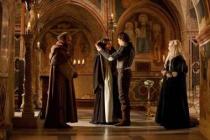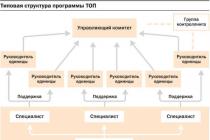Well, a week has passed, and although nothing has settled in my head, I think that I can already express my thoughts coherently. Since Monday I’ve been planning to write a review that claims to be adequate, and not a meaningless collection of sounds. I'll try something.
Perhaps a short background for those who are completely out of the loop with me:
On October 4, 1997, the musical Tanz der Vampire was staged in Vienna, based on Roman Polanski's film The Fearless Vampire Hunters. The music for the musical was written by Jim Stateman, and the libretto was by the famous German librettist Michael Kunze, who is now responsible for most of the cult German musicals. Polanski's original film was a parody of all horror films known at that time, ironic comedies and not a horror film at all. But the Germans approached the story in their own way, with a true West German gothic feel, and turned the comedy into a classic gothic vampire story. but with original humor, which created his unique style.
Short story- Professor Abrontius comes to the Transylvanian village with his young assistant Alfred, in order to confirm his vampirological theories and, so to speak, test them in practice. Local residents so ardently convince the professor that there are no castles in the area that they convince him of the exact opposite. And the guests remain. Alfred immediately falls in love with the innkeeper's daughter, Sarah, and she doesn't even mind reciprocating his feelings. They even manage to sing one aria about each other, but then appears on stage HE. Count von Krolock, Master of the "absent" castle. and also a charismatic, centuries-old vampire. Inviting the girl to his annual ball, he gives her hints. that she will get even more than she wants. Sarah is more than happy with this, so the stakes for Alfred's candidacy drop sharply. Despite all attempts to stop her, the future “prom queen” makes her way through the snowdrifts into the castle. Alfred and the professor are going after him: the first - in the hope of finding and hiding and saving, and the second in pursuit of “their vampires”. End of the first act.
The entire second act is devoted to Alfred's attempts to find and persuade Sarah to escape, and the professor's attempts to deal with a couple of vampires. Well, and also to the count, of course, but I’ll talk about the count separately. Things eventually come to a ball, but the end does not at all correspond to the expected stereotype. This is a German musical, not some American one! If the Germans, in a musical dedicated to Elizabeth of Bavaria, managed to make Death the main character, then what can we expect from a classic vampire story? Right. Aesthetic Western European dark.
The central figure of the musical, whatever one may say, is the mysterious, charming and charismatic Count von Krolock. However, this is a careful adherence to the image of the “classic Gothic vampire”. This is exactly what a real Vampire with a capital V should be: no less than a count, and to look into your eyes and agree to everything. But besides this, von Krolock is also a very sensitive nature and experiences “her curse.” Eternal life, it turns out, is also a very heavy burden. Best of all, of course, conveyed this first and best performer - Steve Barton . The recordings with it are all of a disgusting cyanotic quality, which does not prevent all fans from believing in the Holy Grail that somewhere there are good copies from which the pro-shot was so outrageously copied, and someday they will be stolen from Stage Entertainment again.
The musical captivated the audience so much that next year it will be 15 years old, and it was staged (and is still staged) in many cities in Germany, as well as in Austria, Hungary, Poland, Slovakia, Estonia, Holland, Japan, and now in Finland and Russia.
This is, in fact, what I’m talking about about the St. Petersburg production. I was initially quite skeptical about him, because I didn’t recognize anything other than the German versions. But curiosity is not a vice, and missing out on this was an unforgivable step, so I got ready, bought tickets for November 19 and drove off to St. Petersburg.
After the first viewing, I began to break down, and I frantically began to think about when I could go again. The next day, 15 minutes before the matinee show, I “absolutely by accident” walked by, and “absolutely by accident” went in “just to look,” and woke up already in the hall with a ticket I had bought with my own hands. The second time around it went really well, so I’ll warn you again that the review will be in the spirit of the unforgettable Leimar - “the film is perfect.”
Many thanks to the director of the theater, who chose an exact copy of the production for the production. Because the costumes, sets and makeup are some of the most gorgeous I have ever seen in a musical.
Serene remote village:
It’s immediately clear: who is who
And that there is nothing else to catch in the village.
The castle will be cooler.
Moreover, there is such a graph.
Chip 'n Dale Rescue Rangers
It's the height of genius to stay in this castle overnight
When such inhabitants roam there

Unsuccessful attempts to kill the owner of the castle

Sarah finally came to become prom queen
However, she also likes to lie on the floor (at the count’s feet). The Count is happy.
And everyone is dancing... still.
That is, with the surroundings, scenography, choreography and so on - everything is excellent with the Russian production! No wonder the entire German team came there to do everything at the highest level.
About Russian translation - well, this is the most painful topic. In justification, I will say that translations into other languages are also not verbatim, and that part of the meaning is inevitably lost when adapted into another language. The translators added the pathos of “night, darkness, darkness” and other surroundings. But for those who do not know the original text, this will not spoil the impression. And those who know - well, let's make an amendment in our minds, what is difficult for us? Although, in Russian it also turns out well. I really liked “God Died” in the Russian version.
Well, about the actors:
I was already screaming incoherently somewhere here that Ozhogin really suited the image of the count. See all photos above. He has a wonderful, strong voice, expressive facial expressions (and he knows how to play), and excellent external characteristics - athletic. At two meters tall, Sarah barely reaches his shoulder. Definitely his role. I listen and re-listen. In general, I personally liked the voice, which in my case is a wild bonus.
I haven’t heard Sukhanov live, but I don’t perceive it yet. His voice is too high, too gentle for Krolock, IMHO. With such a voice, he lacks Barton's and Amman's softness. If I get there live, I’ll write again, because the recordings from the audience still distort the sound very much.
Elena Gazaveva - Sarah, I also really liked it. This Sarah knows exactly what she needs and where to get it. No sentimentality, the count said - to the ball, that means - to the ball. It’s a pity for Alfred to let her near her, even if she’s not a Bitch yet, but she already has good inclinations. This image best suits the Russian text.
Vera Sveshnikova turned out to have Sarah as a softer and kinder girl. But the lyrics are more categorical, and therefore it doesn’t fit in a little. Although, of course, she is closer to the original Sarah. Another tossing soul.
Of the Alfreds, I liked Novitsky better. Denisov is also okay, but Gordeev sings and plays better. Denisov is already a Harry Potter boy.
The rest of the cast was the same (except for Rebecca, but who needs her?) Herbert is great, but I don't like his hair. Chagall is also wonderful.
Objectively, the only thing I didn’t like was Magda (N. Bogdanis). Firstly, visually - she has become blonde, and secondly, I don’t like her voice and the way she sings. At all. With such anguish that you want to shoot the cat. But for some reason she also sings in “Night Nightmare”. Yeah. Nightmare...
But overall - it's excellent! It's simply impossible to miss!
At the Moscow Youth Palace, the musical "The Vampire's Ball" replaced "The Phantom of the Opera". He migrated to Moscow from St. Petersburg, where he had been performing for several years and received three Golden Masks. And the Moscow public, despite the first snowfall, rushed along the snow-dusted red carpet to the premiere to see what theater professionals rated so highly.
Everyone left the musical scratching their necks. Some are the backs of their heads. Because the huge teeth depicted on the curtain clicked at the beginning and did not let go throughout the entire performance. Young viewers thought it was stronger than The Phantom of the Opera. Philip Kirkorov looked upset - the role of Count von Krolock (some people also call him Dracula), as it was written for him. Apparently he regretted that it was not he who performed it. Those wise with experience tried to understand what they saw: the meaning shocked them slightly. A Jewish vampire, an Asian vampire, a transvestite vampire, a homosexual vampire... Also an unequivocal promise and prophecy to “everyone living” that a bloody vampire will soon ascend the throne (were the American elections meant)?
Roman Polanski's production is very politically correct. And tolerant. The vampire in it can sing, for example, “My angel, unearthly,” and constantly cry out to God, starting with the first aria “God is forgotten, his name is forgotten...”. These nonhumans, tired of eternal life, spend almost the entire performance in dialogue with the Almighty. But we should not forget that the musical, which has already been watched by more than 7.5 million spectators in 12 countries (Russia is 13th), is conceived as a comedy, irony, and ridicule. Nothing serious.
However, in Russia everything is serious. And the main problem of the new - capital - production is that the genre has not yet been completely decided. The performance “tosses” between drama and comedy. And the viewer doesn’t fully understand whether to cry or laugh. As soon as he begins to empathize with the main vampire, who, for example, performs the “Pechorin” aria in the cemetery (how many destinies have I ruined, but I cannot repent - that’s its meaning. Quote: “Alas, the daughter of a Catholic shepherd did not know the danger...”), how immediately a Jewish vampire named Chagall will give such a “toothed” freylax on stage that you can at least crawl under the red seat.
The uncertainty manifests itself mainly in the performance of the artists. After all, if we praise this domestic production, then first of all for the excellent Russian translation (Susanna Tsiryuk) and choreography (Dennis Callahan). The lyrics and libretto by Mikhail Kunze, the historical production by Roman Polanski and its modern incarnation by Cornelius Balthus are at their best, otherwise the audience would not be flocking to the musical. As for Jim Steinman's music, you're always waiting for Bonnie Tyler to appear on stage. At least as the guest of honor at the premiere. Let us remind you that the main theme and the most beautiful duet of the musical is the composition Total Eclipse, which was performed by the star, for which she received a Grammy.
Head and shoulders above all other performers (in every sense) is Count von Krolock. He is also Ivan Ozhogin. For his role as a vampire, he was awarded the Golden Mask and, as what he saw shows, it was not in vain. He seduces, tempts, leads. Such a vampire cannot be resisted. There is a scene in the play that is not in Roman Polanski’s famous film “The Vampire’s Ball,” when Krolock tries to tempt not only young Sarah, but also the professor’s young assistant, Alfred. And, if we develop this line, we get a very interesting twist: the struggle for the young mind - in which direction to direct it. To serve good or evil? However, many comic films are devoted to this. And about Ivan Ozhogin, it must be said that he is the only “vampire” who was invited to sing this role in the Berlin production. He performs it in two countries and in two languages. And he feels so at ease in it, bathes, improvises, “allows” tragedy where necessary, comedy where necessary, that I want to say: he has already outgrown both the Vampire and the Phantom (the actor also played “The Phantom of the Opera”). Let him grow up to the operatic Mephistopheles in Faust by Charles Gounod. Ripe!
But the vampire is played by his retinue. And in the Moscow production, the St. Petersburg and capital teams are “mixed”. And now they still have to play. First of all, the wonderful and gifted Alfred and Sarah (Alexander Kazmin and Irina Vershkova) need to “strengthen” their roles. But the three artists are very pleasing with their accurate interpretation of the irony and humor that Polanski incorporated into the musical (an interview with him was published earlier in RG, fragments were included in the program booklet of the musical). First of all, this is the son of Count von Krolock - Herbert. The character in the musical turned out to be even more interesting than in the film. Kirill Gordeev also played in the St. Petersburg production. With his first appearance on stage, the very necessary comedic mood is created. Alexander Sukhanov, playing the role of the Jewish vampire Chagall, hits the right tone. And, of course, Professor Abronsius is the main character of the musical, no less than the Vampire King. Andrei Birin, who talentedly plays this role, is always in search of the necessary “note” - and it shows. At the same time, his professor is very original. And when the artist finally decides (after all, the premiere is a special occasion), it will be unique. Although the professor, he is also always looking for something.
Despite all the criticism, the artists should be given their due - try dancing and especially singing with huge false teeth in your mouth. Who said being a vampire is easy? But what everyone who took part in the creation of the play managed to show: how vampires are tormented every new evening and night, what lengths ghouls go to in order to diversify the heavy burden and time in which “only death can become the guarantee of eternal life ". They even look like zombies, these vampires. This search and selection of a new victim, the confusion of seducing her and the highest creativity is to figure out exactly how the first bite will occur. However, the same applies to the relationship between the directors and the audience.
When you approach the MDM entrance, you immediately notice that the theater has turned into the mystical castle of the vampire Count von Krolock with black Gothic gates. Then you immediately understand that something mysterious, dark and enigmatic awaits ahead...
The Vampire's Ball is a cult musical based on the 1967 Roman Polanski film The Fearless Vampire Killers. In 1997, a stage version from VBV was created in Vienna, which gained enormous popularity, winning the hearts of millions of viewers. The musical came to Russia in 2011, then it took place on the stage of the Musical Comedy Theater in St. Petersburg. And now, five years later, “Ball of the Vampires” reached the Moscow stage. The production is distributed by the Russian division of Stage Entertainment, for which Roman Polanski's musical became the eleventh Russian production. The director himself considers the film his best creation, although, of course, it stands out from other Polanski works. The love for “Fearless Vampires” is explained by the fact that his wife Sharon Tate, who tragically died, played there.
The plot of the musical almost completely repeats the content of the 1967 black comedy The Fearless Vampire Killers. Abronsius, a professor at the University of Königsberg, arrives to a nondescript village somewhere in Transylvania with his student assistant Alfred in order to prove the existence of vampires. The travelers stop at an inn, owned by a middle-aged man, Yoni Chagall, who lives there with his wife Rebecca and daughter Sarah. While Ambronsius unsuccessfully tries to obtain information about vampires in a garlic-lined tavern, Alfred falls in love at first sight with Chagall's beautiful daughter. However, she is soon kidnapped by the treacherous vampire Count von Krolock, forcing the professor and his assistant to quickly get to the mysterious castle.
A lot has been said about vampires in cinema, from Nosferatu to Count Dracula. Actually, von Krolock is a similarity to the character in Bram Stoker’s novel. Only Polanski didn’t want to make another horror story; “The Fearless Vampire Killers” is a parody of all the films about blood-sucking evil spirits that had come out in Hollywood by the mid-60s. The film has more than enough black humor, which is its highlight. Professor Ambronsius, who looks like a kind of eccentric Einstein, is simply obsessed with the vampire theme. His assistant Alfred is clearly not very keen on this idea, but in order to help his mentor, he reluctantly looks for vampires. Beautiful Sarah, in turn, cannot boast of anything except her dazzling appearance and the need to constantly take a bath. Actually, Roman Polanski wanted the musical to also be ironic, without bias towards the serious problem of the relationship between good and evil.

However, the creators of “Ball” did not make do with just black humor and ridicule of the vampire theme. On the contrary, everything connected with bloody evil spirits has now reached a serious level. The vampires here are beautiful and captivating aristocrats who can turn the head of any unlucky girl. Likewise, the vampire castle has become mysterious and gloomy, there is nothing comical in it anymore. Von Krolock himself appears as a demonic principle who is capable of deciding the destinies of people. There is, of course, humor in the production, but it is the responsibility of Professor Ambronsius, Alfred, the owners of the inn and only one vampire - von Krolock's son Herbert. The comic situations the characters find themselves in are taken entirely from the film version of the story.
Thus, the world of “Ball of the Vampires” was divided into two – the comic human one and the mysterious vampire one. Although, of course, when fearless and noble vampire killers end up in the castle, funny incidents begin to happen to them there, mixing these worlds.

In the middle of two worlds is the beautiful Sarah, who, unlike her prototype in the movies, comes to the castle herself, enchanted or bitten by von Krolock. Probably, by this the creators wanted to show the duality of human nature, which passes from good to evil.
The romantic line between the young assistant and Sarah became clearer in the production, explaining the presence of lyrical compositions in the musical. The young girl chooses here between the clumsy and timid Alfred and the stately, mysterious Count. Doesn't remind you of anything? Personally, this story reminded me of the plot of “The Phantom of the Opera”, the release of which only recently ended on the MDM stage. Indeed, one can recall Christine Daae, who chose between her childhood friend Raoul and the brilliant Phantom of the Opera. The similarity is strengthened by the fact that in Ball of the Vampires Count von Krolock is played by the talented actor Ivan Ozhogin, who also played the Phantom. By the way, Ozhogin successfully played in the German version of “The Ball”, becoming the standard performer of the role of von Krolock.

Sarah arrives at von Krolock's castle. Photo: Yuri Bogomaz
But the production rather benefits from its similarity to The Phantom of the Opera. The craving for the unknown and mysterious is always popular with viewers. Becoming a story similar to the legendary creation of Andrew Lloyd Webber, "The Fearless Vampire Killers" turned into an alluring, mysterious and sophisticated "Vampire's Ball."
All parts in the musical are dynamic and memorable, which is not surprising - the composer of the production was Jim Steinman, songwriter of Celine Dion and Bonnie Tyler. One of the main themes of the “Ball” is Tyler’s song Total Eclipse of the Heart (“Total Eclipse of the Heart.” – Note “365”). The actors of the production give their best not even 100, but 200%. It’s not enough to say about the amazing vocal abilities of the artists, because a musical is not an opera, so the emphasis here is more on the dramatic abilities of the performers. You really get immersed in the performance and begin to empathize with the characters. This is also quite logical, because the cast was personally approved by Roman Polanski. Thus, the performers of the roles of Sarah and Alfred, Irina Vershkova and Alexander Kazmin, met with the director in Paris, where he gave them valuable advice and persistently emphasized that everything in the musical should be imbued with irony.

The musical is being shown in Moscow for the first time, but in St. Petersburg it ran successfully for five whole years. The set design for these productions is identical to that of the original Viennese version of the musical. They also did not make a new translation of the songs. Even half of the troupe “moved” from St. Petersburg to Moscow. I wonder if these productions are different from each other? I decided to ask this question to a fan of the musical, Angela Gordiyuk, who has seen Roman Polanski’s legendary production several times.
“There are still differences, they are largely at the level of sensations. First of all, for the Moscow production the text was slightly changed - it was significantly smoothed out, depriving it of provocativeness. This is quite expected in the cultural situation of the capital. Thus, von Krolock’s opening aria underwent a significant transformation - initially it was “God is dead/your God is dead, his name is forgotten”, but it became “God is forgotten/his name is forgotten”. But this was a direct translation from the original musical, which Nietzsche quotes. Other changes are also noticeable - it was “How lovely is your ass”, and became “How graceful is your figure” (duet of Alfred and von Krolock’s son Herbert, who was inflamed with passion for the young assistant. - Note “365”). In general, Herbreth’s “pickup” was somewhat smoothed out, giving the image of the vampire greater aristocracy. As for the overall experience, the Moscow production is in no way inferior to the St. Petersburg one, but the impressions are different. “The Ball” lost the intimacy of the Musical Comedy Theater (850 seats versus 2000 at MDM. – Note “365”), so the interactivity of the action was lost, since the central aisle could not be used by wandering actors. And yet the impression when another vampire jumps onto the curb of the benoir box is indescribable,” Angela shared with “365”.

But special effects are also present in MDM, and the interactivity of the production has not gone away either. The involvement of spectators in the process has become less, but the vampires still scare when passing by spectators sitting near the side exits. The very appearance of vampires on stage and in the hall is interesting. It happens so imperceptibly and technically perfect that every time it comes as a complete surprise and is perceived as real magic. This is also facilitated by moving scenery, in which 3D screens were used. This creates a more complete effect of immersion in the action taking place. For example, before the scene when Ambronsius and Alfred go to the vampires' castle, images of a gloomy Gothic structure, clearly reminiscent of Cologne Cathedral, are projected on the curtain screen. And when we find ourselves with Sarah in the castle’s living room, she is surrounded by moving portraits of von Krolock’s ancestors. The production features a total of 75 sets that immerse you in a mystical atmosphere.


The musical turned out to be really exciting and interesting. “Despite the fact that it is a parody, the musical has great depth - both in terms of philosophy, psychology, and thanks to the cinematic accuracy of the characters. This makes the viewer come again and again. This musical doesn’t let you go - I know people who have seen the play more than a hundred times,” says Ivan Ozhogin, who plays Count von Krolock, about “The Ball.” Indeed, as soon as you leave the hall after the end of the performance, you immediately realize that you want to return to the “Vampire Ball” again.
Text: Natalya Shulgina
On September 3, 2011, at the St. Petersburg Theater of Musical Comedy, for the first time in Russia, they began showing the famous “Ball of the Vampires,” a musical based on Roman Polanski’s 1997 film of the same name. And not a touring version, but a full-fledged Russian-language performance, a transfer of the Viennese version of 2009, improved in accordance with the latest capabilities of theatrical technology. Under the terms of the license, St. Petersburg has exclusive rights to stage Ball of the Vampires in Russia for the next two years.
So, a little about the history of creation and the performance itself.
In 1967, the famous director Roman Polanski made a film on a very popular theme in cinema - about vampires. The film was originally titled "Vampire Ball"
, in the American box office it was released under the name "The Fearless Vampire Killers or Sorry, but your teeth are in my neck"
.
The film was a success in Europe, but was a complete failure in America due to the fact that it was cut by as much as twenty minutes, completely distorting the storyline.

Andrew Brownsberg, Roman Polanski's colleague and producer, suggested that he turn Ball of the Vampires into a musical. They met in Vienna with the director of the Vienna Theater Association to discuss this possibility, and ultimately decided that the best candidates to realize their vision were composer Jim Steinman and librettist Michael Kunze.
Jim Steinman, songwriter of Meat Loaf and Bonnie Tyler, co-author of Andrew Lloyd-Webber, universally recognized Prince of Darkness and vampire, talented musician and poet, a big fan of the work of Roman Polanski in general and his vampire film in particular, gladly agreed to participate in the project.
It took about four years to turn the film into a play. On July 21, 1997, three decades after the film's release, rehearsals began, and on October 4 of the same year, the premiere of the musical took place at the Raimund Theater in Vienna, which had the same name as the film - "Dance of the Vampires." The play was a great success and ran for 677 evenings.

The musical takes place at the end of the 19th century.
Professor Abronsius and his assistant Alfred come to Transylvania in search of vampires, which the professor specializes in studying. Stopping at a tavern belonging to a certain Chagall, the professor realizes that he is close to his goal - the villagers are singing a song of praise to garlic, a well-known means of fighting vampires. Chagall and his family, however, deny the fact that vampires are somewhere nearby. Alfred, meanwhile, is busy with something else - he and the daughter of the innkeeper Chagall, the beautiful girl Sarah, understand that they really like each other.

But not only Alfred likes Sarah - Count von Krolock invites the girl to his castle for a ball. He gives her magic shoes, which she puts on and runs away to him (unlike the film, in which the Count kidnaps Sarah right from the bathroom). Chagall leaves to look for his daughter. The next morning he is found dead.
Chagall becomes a vampire. The Professor and Alfred are restrained by Chagall's wife from stabbing him with an aspen stake, deciding instead to follow him to von Krolock's castle, where they believe Sarah is. Chagall kills Magda, his maid and at the same time his mistress, thereby turning her also into a vampire. The Count welcomes them to his castle and introduces Alfred to his son Herbert.

Sarah is already attracted to the mysterious Count, but he is not going to seduce her right now - until the ball. Alfred is haunted by nightmares - he dreams that he is forever losing his beloved girl. During the day, the professor and his assistant try to get into the Krolock family crypt - in the end Alfred manages to do this, but when he sees the count and his son sleeping in coffins, he does not find the strength to kill them. A little later, he finds Sarah in the bathroom and persuades her to run away with him, but all her thoughts are occupied with the upcoming ball. Alfred's thoughts about his love for Sarah are interrupted by the appearance of Herbert - he, it turns out, is also in love, but not at all with Sarah, as you might think, but... with Alfred. The professor, who arrives in time, saves his assistant from the “addictions” of the young vampire.

Vampires from all over the area crawl out of their coffins and gather for the ball. Von Krolock at this time indulges in sad reflections about his fate - one of the culminating songs of the musical, “Endless Thirst,” is a kind of “anti-hymn” of the consumer society of the 20th century. The ball begins. The Count dances with Sarah - she has lost a lot of blood, but is still alive. Alfred and the professor sneak into the ball in disguise, but the vampires notice that they are reflected in the mirror, and the heroes, taking Sarah with them, run away, but the one who laughs last laughs best.

The professor is too inspired by the successful escape and is carried away by his scientific research, so he does not notice what is happening behind his back - Sarah, who has become a vampire, bites her lover. The vampires in von Krolock's castle rejoice - their regiment has arrived... This night the vampires will dance...
In the finale we are transported to modern times, where the world is ruled by murderers and scum - a wonderful beginning for Blade or Underworld.

It should be noted that one of the main themes of the musical is the melody from Bonnie Tyler's hit "Total eclipse of a heart", which received a Grammy Award in 1983. Composer Jim Steinman wrote this song as a memory of the film Nosferatu (the first film adaptation of Dracula) and could not resist the pleasure of introducing it into a theatrical production about vampires.

For 14 years, “The Vampire's Ball” was seen by millions of viewers in Austria, Germany, the USA, Japan, Hungary, Poland, Belgium, and Estonia. In 2009, the authors created a new, Vienna version of the musical, with a more vibrant stage design. Hungarian production designer Kentauer imbued the production with a gothic sensibility, and music supervisor Michael Reid re-arranged all the orchestral material. Thanks to the skill of Cornelius Balthus, co-director of Roman Polanski, the production has become even more graceful, profound and acquires many witty nuances.

The scale of the project can be judged by facts alone: during the performance, the scenery is changed 75 times, more than 220 original costumes, wigs and makeup variations are created, and assistant directors must order various stage changes 600 times!
I especially want to focus on the costumes of Count Krolock. They are incomparable. Silk and velvet combined with good taste. The result is a classic image of an aristocrat-vampire.

Perhaps the hardest thing is for the performer of one of the main roles, Ivan Ozhogin: the Moscow actor plays Count von Krolock. Each time, the directors anticipate with horror the torment of makeup: to turn the Russian Ivan into the Transylvanian von Krolock, it takes at least an hour and a half, and so on every day.
But the most difficult thing is the teeth. Especially for Ivan and other “vampires,” St. Petersburg dentists made characteristic jaws with fangs. During the rehearsals, Ivan managed to bite himself more than once with “vampire teeth”: the fangs still feel like a foreign body, interfere with singing, and even injure the mouth.
This musical is a choreographer's dream, entire scenes are one continuous dance, like in the finale of the second act.

Now, more about the artists involved in the Russian premiere.
For the Russian premiere of Ball of the Vampires, auditions took place in three stages, even for choir and ballet dancers.
Moscow artist Ivan Ozhogin, who was cast in the central role of the vampire aristocrat Count von Krolock, managed to travel to Europe, meet the Krolocks from Austria and Germany and receive valuable recommendations from them.

"- I visited Warsaw, Berlin, Stuttgart, Vienna, Salzburg, and caught a piece of Italy and the Czech Republic. That is, I traveled around Europe by car, but the main purpose of the trip was to watch the German and Austrian versions of “The Ball of the Vampires” and get acquainted with the famous Western Krolocks: Kevin Tart and Drew Sarich.
- The musical “Vampire's Ball” is performed in many European countries. But this is an exceptional case for the leading performer of Ball of the Vampires from a country where the premiere is just being prepared to come to take over the baton from the current performers."

File of Ivan Ozhogin, musical theater and film actor, tenor.
Born in 1978. In 2002 he graduated from the Russian Academy of Theater Arts (GITIS) with a degree in musical theater artist (course of A.B. Titel and I.N. Yasulovich). He played at the Musical Theater named after. K.S. Stanislavsky and Vl.I. Nemirovich-Danchenko (“Betrothal in a Monastery”, 2001), at the Helikon Opera Theater (Count Yusupov, “Rasputin”, 2008).
Participated in Russian musicals: “Chicago” (Mary Sunshine, 2002), “Wedding of the Jays” (2003), “Nord-Ost”, touring version (Romashov, 2003), “Cats” (Munkustrap, 2005), “Black Bridle of the White mares" (Jewish prophet Agits-in-Parovoz, 2006), "Beauty and the Beast" (Monsieur Darkness, 2009-2010), the show "Broadway Stars" (2010-2011).
Soloist of the choir of the Nikolo-Ugreshsky Stavropegic Monastery since 2005. Soloist of the choir “Bolshoy Donkozaken” (Vienna, Austria). Concerts in Russia and abroad.
Before becoming a vampire, Ivan sang character roles in Moscow musicals, and also sang as a soloist in the choir of the Nikolo-Ugreshsky Stavropegic Monastery. When asked whether there was a role in his creative biography comparable in scale to the role of Krolok, he names Romashov in the touring version of “Nord-Ost” (2003).

Alfred (actor Georgy Novitsky) - the hero who was played by the director himself in the film “The Fearless Vampire Killers” by Roman Polanski.

Elena Gazaeva - performer of the role of Sarah.

Professor Abronsius, vampireologist (actor Andrei Matveev) . Roman Polanski, who, as we know, revered life as such in all its incomprehensible manifestations much more than science with its utopian desire to reveal all the secrets of life, made Abronsius look like Einstein. In the musical, the portrait approach to the image, as well as the parody of the image itself, is preserved.

I really want to mention the makeup as such. For example, Kukol’s is really very, very effective, like many other vampires’.

The additional storylines of the elderly womanizer Chagall and the maid Magda looked funny.


An equally interesting character is Herbert - the son of Count Krolock.

Well, if you still try to get to the essence of the role of Count von Krolock, then death in this case is presented as a manifestation of human qualities. And Krolok turns out to be such a mirror both for the heroes of the musical, and for the audience in the hall, for today’s society: “So you accuse me of being a vampire? But it's not my fault - I was born this way, and I've lived with it for 400 years. Don’t you drink the blood of your neighbors - out of love for money, out of love for power? And look how many young girls marry rich old men - this is the norm here. In me you see your reflection..."

The personal drama lies in his immortality. The fact is that he cannot die. He's bored to death, and besides, he sees where the world is heading.

There are dozens of fan clubs for this musical, and the most devoted fans try to watch all the original versions of Ball of the Vampires in different countries. The performers of the role of Count von Krolock gain truly popular love. At the invitation of the Russian group "Ball of the Vampires", the star of the European musical theater Kevin Tart (German von Krolock) came to the premiere of the musical in order to greet his Russian colleagues. So, the start of the premiere of “Vampire Ball” has been given!
Some more scenery and actors from the play.














Part 1 - Musical "Vampire's Ball"

"The Vampire's Ball": what do we know about the musical based on the film by Roman Polanski
In 2016, the premiere of the musical "The Vampire's Ball" took place in Moscow - one of the most anticipated and successful musical performances, which is still sold out. On the eve of the spring season, we are revealing even more secrets of this production in the format of “10 little-known facts about the play.”
2017 is the anniversary year for the Vampire Ball. The musical is based on Roman Polanski's cult film "The Fearless Vampire Killers, or Sorry, but your teeth are in my neck." This year marks the 50th anniversary of the film and the 20th anniversary of the musical. Director Roman Polanski calls the filming period the best time of his life and likes to repeat that there is no hidden meaning or edification in his black comedy. 
One of the main characters in the play looks the same as Roman Polanski in the film. Polanski played in his film the young student of Professor Abronsius, Alfred, who falls in love with the beautiful Sarah and goes to the lair of Count von Krolock to save her. The director insisted that in the stage version Alfred look exactly the same as in the film - a burgundy velvet jacket, an awkward bow around his neck and disheveled hair.  The main characters of the play are Sarah and Alfred
The main characters of the play are Sarah and Alfred
Scenes in the play change 75 times - more often than in The Phantom of the Opera. The musical "Vampire's Ball" amazes with its entertainment and scale. This project uses dozens of winches to provide instant scenery changes. By the way, Count von Krolock's castle has been recreated almost completely - from the bathroom to the bedroom.
Among the vampires who arrived at the ball, you can find familiar faces. In the images of vampires that come to Count von Krolock, you can see the greatest villains in history. Vlad the Impaler Dracula, Elisabetta Bathory, who loved to bathe in the blood of young girls, as well as Delphine LaLaurie, who abused slaves, and the serial killer Gilles Dere, who was the prototype of Bluebeard, appear before the viewer. Ludwig of Bavaria looks like an innocent child in such company - he just lived as a recluse, slept during the day, and at night walked in the moonlight around the lake on his estate. In total, more than 230 costumes were used in the musical, among which there are real treasures - for example, shirts of peasants from Transylvania, which are more than 100 years old. 
In the rhinestones present on the costumes of the heroes, you can see special signs. Sarah's burgundy ballgown, a gift from the Count, is decorated not only exquisitely, but also symbolically. It is embroidered with red stones, which symbolize flowing blood. And if you look closely at the pattern of rhinestones, you will notice that they are laid out in the shape of a skull. Detail is the main feature of the musical. For example, the symbol of eternal life Ankh - the family coat of arms of Count von Krolock - is not only found in the decorations of the castle, but is also lined with rhinestones on his cloak.  Von Krolock's cloak and symbol on it
Von Krolock's cloak and symbol on it
Over the past 10 years, vampires have become sexier. During the existence of the musical, the appearance of vampires has changed significantly. 10 years ago they were scary, scary monsters. But after the release of the films "Twilight" and "The Vampire Diaries," the public's perception of vampires changed. The creative team developed new makeup and hairstyles to make the vampires more beautiful and sexier. 
Ivan Ozhogin, who plays Count Von Krolock, once scared a traffic police inspector. The main attribute of a vampire is teeth. Fangs for each artist were created separately. First, a cast of the teeth was made, then a model of the fangs was made by hand from wax. A silicone impression was made from it, which was filled with plastic, after which the mouthguards were individually adjusted to the actors, so wearing such teeth is relatively comfortable. There is a well-known story of how once the leading actors in a musical, Ivan Ozhogin and Elena Gazzaeva, drove from one shoot to another without having time to remove their makeup.
We had just completed filming in “Evening Urgant”, and we needed to be in time for a photo shoot that took place in the restaurant,” Ivan recalls with a laugh. - There was no time to re-make up, so I had to move around in my images from the play. We go, we don’t bother anyone, we rehearse the duet “Pitch Darkness”. Suddenly, out of nowhere, a traffic police officer appears in front of the car. I tell Lena to pretend to be asleep, and I open the window and smile at the employee. He looks into the car, assesses the situation, and, without even looking at the documents, says: “Drive, but be careful!” And he himself is so attentive and attentive.
Most of the time is spent on makeup for the characters Von Krolock and Kukol. Before each performance, 4 characters spend about an hour and a half on makeup: Count von Krolock, his son Herbert, Professor Abronsius and Kukol. The Count's makeup takes more than 2 hours. The makeup of von Krolock and Herbert affects not only the face, but also the hands, because they must have long false nails. They are painted by hand with special varnishes of several shades. The ugly henchman Count Kukol has the most complex prosthetic makeup. Silicone pads made according to the shape of the artist's face are glued to his face. They include the cheeks, nose, chin, eyebrows, lip and ear, then makeup is applied on top and the scars are painted on. The effect is so impressive that when this character appears, viewers often shudder. 
The blood that the viewer sees in the play has a cherry or strawberry flavor. To make the bite look impressive and the blood to really splatter, special capsules with blood are prepared for the artists, which they bite into at the right moment. Blood comes in 2 flavors - cherry and strawberry. It is made from corn syrup with the addition of food coloring.
There is a CD with music from "Tale of the Vampires". In honor of the anniversary, the Stage Entertainment company has prepared a gift for all fans of the play by recording and releasing the first licensed album of the musical “Ball of the Vampires” in Russian. The album features 11 hits from the show, written by composer Jim Steinman, performed by the stars of the musical, accompanied by an orchestra. All tracks are recorded in live format, which will help listeners to fully immerse themselves in the atmosphere of the show and feel the “live” emotions of the artists during the performance. The disc can be purchased at the theater and on the official website of the performance.

















